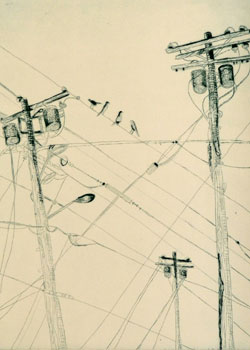Printmaking exhibition opens
START Gallery’s first spring exhibition, “Lightening Strikes: The Illumination of the Self,” runs through Feb. 25. The show features works by 18 students who studied in art professor David Faber’s introductory, intermediate or advanced printmaking classes in fall 2011.
In the following Q&A, David Faber talks about the exhibition and how he inspires his students.
What kind of art is featured in this show?
The exhibition features the fine art printmaking processes of “relief.” Relief refers to woodcuts or linocuts (designs carved in relief on a block of wood or on linoleum). In this exhibition, students used linocuts. Recessed grooves in the copper plates retain ink, and when transferred to paper through the use of an etching press, form the dark positive image in reverse to the image on the plate. Henri Matisse and Pablo Picasso validated this form of art. In fact, Wake Forest owns a Picasso linocut as part of the Student Union Art Collection.
How did the idea for ‘lightning strikes’ develop?
While working on the 8th edition of my drawing textbook, “A Guide to Drawing,” I was looking for images of lightning strikes for the chapter on landscape. I ran into one brick wall after another and decided that I would fashion an assignment for my printmaking students about creating lightning strikes.
The title simply implies a ‘flash of light.’ One way I can describe this is what I see in my students—the lightning that lightens and illuminates their faces. My prescribed investigations of my students’ faces came about as a result of these atmospheric flashes (lightning strikes) that illuminate their faces, revealing their souls and spirits in an extraordinary way and unlike any other form of illumination.
What did you tell your students to help them create this art?
I posed this question: “What makes our brains register lightning as lightning and not a branching tree or portion of a root system or the veining of a vascular system?” We see a lightning strike and know immediately that it was lightning and nothing else. We also realize the ephemera of a strike — that it happened uniquely and will never happen that way again. I asked the students to parallel the creative process with the ephemera of lightning and come to their personal conclusions of meaning and association.
What will viewers see in Lightening Strikes?
The exhibition includes intaglio prints (art created using methods of cutting, scratching, and/or etching images below the plate surface), which use both single and multiple plates in the forms of line etching, stippling (marking the surface with small dots) and aquatint (a print that looks like a watercolor and is produced from a copper plate etched with nitric acid). Images in the show include: telephone poles, clusters of grapes, snakes, and octopus appendages.
What do you hope your students learn by having their work featured in an exhibition?
First, they will gain an awareness of what is meant by a unified body of work and all that goes into the production of an exhibition. Second, they will have the opportunity to view their work in a different context outside of the studio proper. Third, they will experience the business side of the art world, albeit a sheltered one within our campus.
Categories: Arts & Culture, Experiential Learning, Research & Discovery
Media Contact
Wake Forest News
media@wfu.edu
336.758.5237




